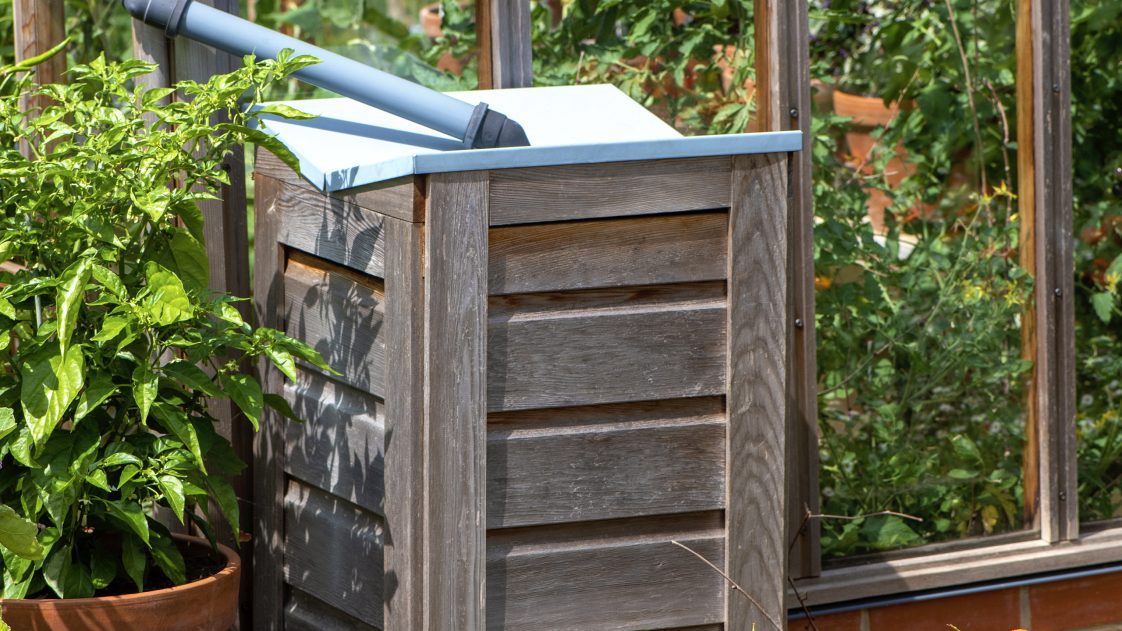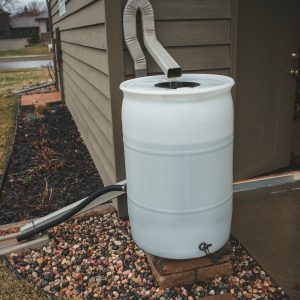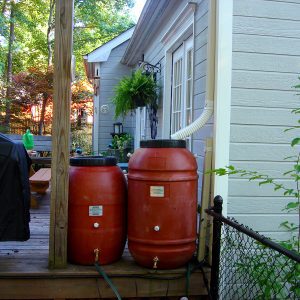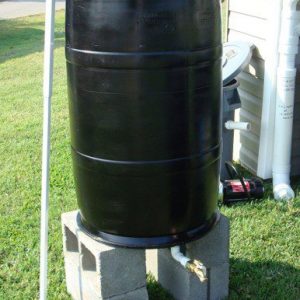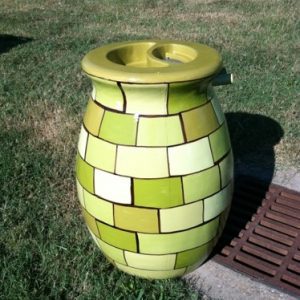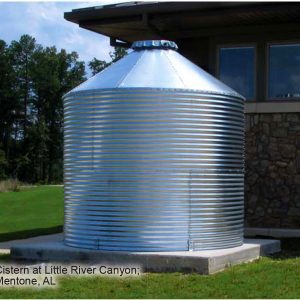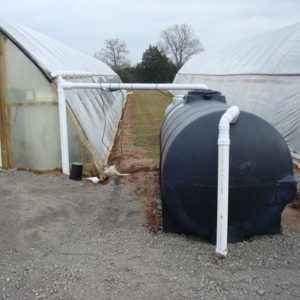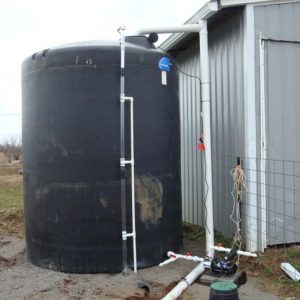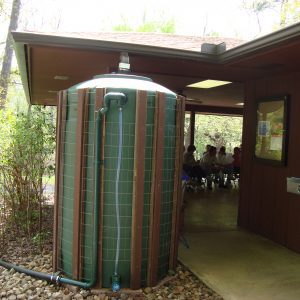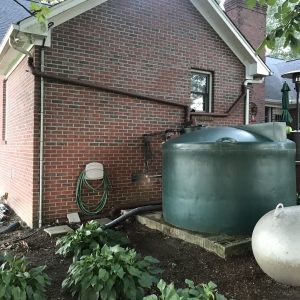Fish & Water

What Is It?
Rainwater harvesting is the collection and storage of rainwater in a container or in the landscape through a designed practice. Rainwater is usually collected from rooftops, greenhouses, sheds, and other relatively clean surfaces. This stored water can be used for irrigation, washing cars, and flushing toilets.
Harvested rainwater should only be used for drinking water if system treatment components have been included. Water purification requirements vary with state and local ordinances, and systems must be inspected by local authorities.
All rainwater harvesting systems are comprised of the following:
- Catchment area (roof) where rainfall is collected
- Conveyance system (gutters, downspout, rain chain, or sheet flow), which helps to transport water
- Storage system (rain barrel or cistern), which holds the water for later use
Though rain barrels and cisterns differ in size and shape, both are rainwater harvesting systems, and the main components remain consistent. Rain barrels commonly are used to harvest rainwater since they typically are more readily available for purchase and relatively inexpensive. Barrels are used for small-scale rainwater harvesting and sized to hold less than 100 gallons. With the right tools, a rain barrel can be built for less than $20.
- Figure 5. Catchment roof with gutters leads water into a conveyance PVC pipe, transporting water into a cistern.
- Figure 6. Rain barrels
- Figure 7. Rain barrel made out of recycled syrup barrel, placed upside down with a PVC connector
Rainwater can be harvested on a larger scale through the use of cisterns. A cistern is a storage tank with a storage capacity of more than 100 gallons. Cisterns come in all shapes and sizes, can be made of a diverse array of materials, and may be installed either above- or belowground. Cisterns tend to be more complex than rain barrels; they typically employ some type of filtration system to remove pollutants before they reach the tank, and they often require a pump system to convey the water across the landscape.
Because professional help is often needed to install large-scale cisterns, this guide focuses on do-it- yourself smaller rain barrels. For more information on cisterns, see Rainwater Harvesting for Irrigation Water.9
- Figure 8. Smaller decorative ceramic rain barrel with filter
- Figure 9. Cistern at Little River Canyon, Mentone, Alabama
- Figure 10. A 1,000-gallon rain tank, Moulton, Alabama
Did You Know?
A 1-inch rainstorm falling on a 1,000-square-foot rooftop (almost half the size of a tennis court) will generate over 600 gallons of runoff. To visualize, imagine filling one and a half hot tubs with water after a 1-inch rain event!
- Figure 11. A 3,000-gallon rain cistern, Moulton, Alabama
- Figure 12. Cistern collecting rooftop rainwater through gutter system
- Figure 13. Rainwater harvesting tank with downspouts and first flush diverter
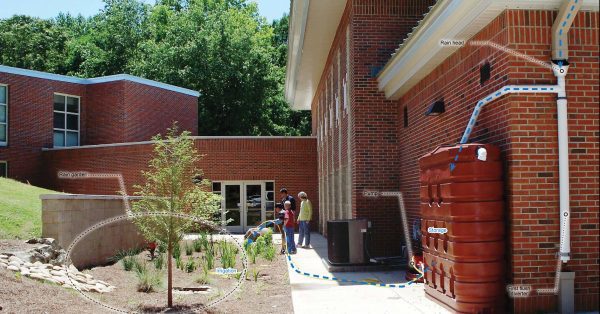
Figure 14. Cistern in use with a rain garden. Note the prefiltration devices on the right including the first flush diverter and rain head collecting water from the downspout.
Rainfall in Alabama
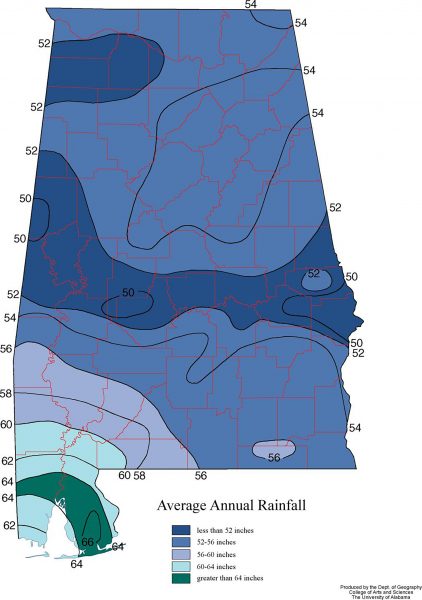
Figure 15. Average annual rainfall in Alabama. (Photo credit: ADECA-OWR)
Most of Alabama experiences a humid subtropical climate, with very hot summers, mild winters, and precipitation throughout the year. Alabama is vulnerable to thunderstorms, tropical storms, floods, and droughts. Figures 15 and 16 demonstrate Alabama’s rainfall amounts in a given year across the state.
As stated previously, the average yearly precipitation in Alabama is 56 inches. With frequent thunderstorms and tropical storms in the summer, the coast is wetter than the interior, receiving 60 inches (152.4 millimeters) of rainfall. August to October tend to be the hottest and driest periods in the northern and central portions of Alabama. During these months and in times of encouraged water restrictions, having a rainwater harvesting system has additional benefits.
To estimate how many gallons of water you can harvest from your rooftop over the course of a year, or during a single rain event, fill in the following equation:
___ catchment area (ft.2) × ___ rainfall (inches) × 0.5* (gallons per foot) = ___ harvested water (gallons)
*Collection efficiency is affected by leaks, wind, rainfall rate, etc. During a slow, gentle rain, with no leaks in the system, collection efficiency is about 95 percent. During a very fast, heavy rain, the efficiency would be closer to 50 to 75 percent because gutters overflow and gutter covers are overrun with water.
You can refer to Alabama Extension’s Rainwater Harvesting for Irrigation Water 10 to estimate how much water you may need to harvest to irrigate a 2,000-square-foot vegetable garden.
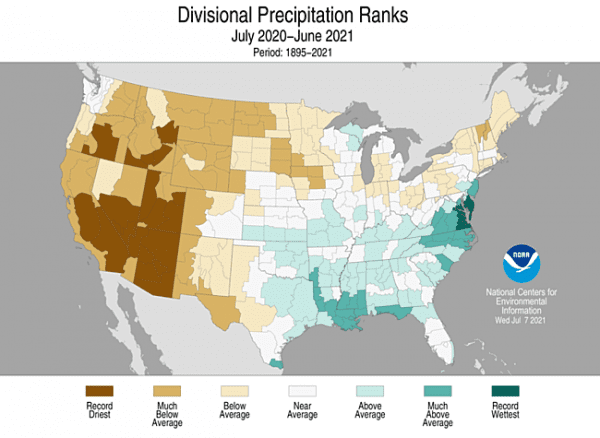
Figure 16. County precipitation ranks, February 2020. Credit: National Oceanic and Atmospheric Administration

Figure 17. Heavy rainfall. (Photo credit: Vidar Nordli Mathisen, Unsplash)
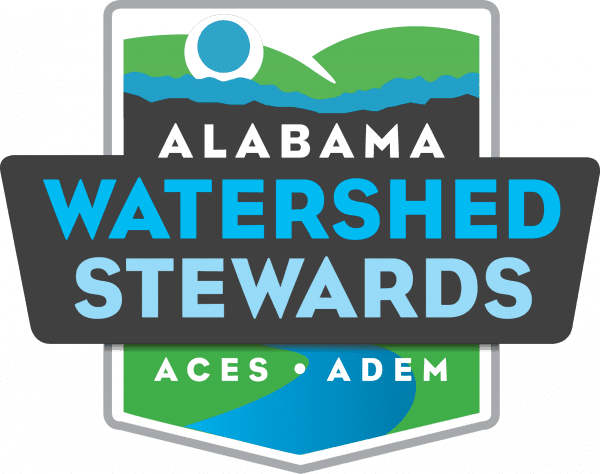
 Laura Bell, Project Coordinator; Eve Brantley, Extension Resources Specialist and Professor; Naomi Pitts, Watershed Program Assistant; and Caitlin Sweeney, Watershed Program Assistant, all with Alabama Extension Water Program, Auburn University
Laura Bell, Project Coordinator; Eve Brantley, Extension Resources Specialist and Professor; Naomi Pitts, Watershed Program Assistant; and Caitlin Sweeney, Watershed Program Assistant, all with Alabama Extension Water Program, Auburn University
Special thanks to Rhonda Britton, Regional Extension Agent, for her contributions to this handbook.
New August 2021, A Homeowner’s Guide to Rainwater Harvesting in Alabama, ANR-2794

